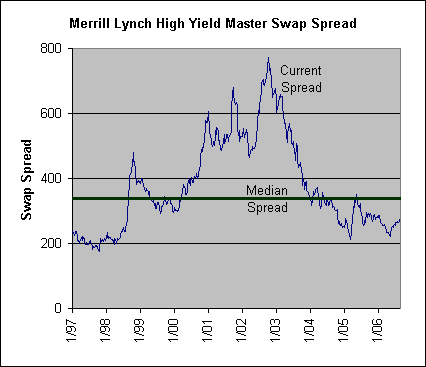A commenter recently asked my opinion of high-yield spreads, so I'll give it. But first, let's go over the facts.
First, junk is not like the boring old corporate bonds I'm more involved with. If you take two high quality corporate names in similar industries, like Bear Stearns and Lehman Brothers, they are going to tend to move together. That's because almost all investment grade companies are in good financial shape, the probability of default is remote. If Lehman Brothers misses earnings by 5 cents, it doesn't really change anything about their credit worthiness. It would take a either severe turn of fortune or a very sustained period of poor performance to take down a company like Lehman. So bonds tend to move day to day on the general market appetite for corporate risk, and less on anything company specific.
Junk is completely different. Those companies have relatively weak financials, and it wouldn't take as much to push them into default. Junk bonds move more like stocks: there is a general market element but there is also a very strong company specific element. That means if you are good (or lucky) you can pick the right junk bonds and perform quite well even when spreads generally are widening. Now, I can make an argument that a lot of "successful" junk managers have been more lucky than right, but that's a post for another day.
Below are junk spreads are very tight compared to recent history. They aren't as tight as some people seem to think. Take a look at the chart below.
The blue line represents the current swap spread (spread over LIBOR swaps) and the green line is the median for this time period. I used the Merrill Lynch High Yield Master Index. The current spread is 276 and the median is 340. So the current spread is about 66bps tighter than average. Looking at the graph, though, its hard to say whether the median is a good indicator of "typical" spreads. From 1997-2000 and most of 2003-2006, spreads where generally between 200 and 400. But from 2001-mid 2003, spreads persistently higher than +500. So I'm not sure historical averages tells the story.
I attack the question a different way. According to Moody's, from 1983-2005, 35.5% of all "Speculative Grade" corporate bond issues will default by the 10th year after issuance (Source: Default and Recovery Rates of Corporate Bond Issuers: 1920-2005). The average recovery rate after default for all bonds was 36% for the same period. Using these numbers, you'd figure that if you owned a diversified portfolio of junk issues, 35.5% of them would default over 10 years, and you would take a 64% loss on that portion of your portfolio. That's a cumulative loss of 22.7%. In addition to taking the loss, you lose earning power on the bonds that default. So how much annual spread do you need to make up for the expected credit losses?
In order to have truly "made up" for the losses, I figure the high-yield portfolio has to perform at least as well as a portfolio of AAA/AA corporates. This is why I use the swap spread as the basis for the analysis. If you use Treasuries, then you are really ignoring the primary alternative to a high-yield portfolio: an investment grade corporate portfolio. I then use Moody's data to estimate when each loss will occur and therefore how much coupon income is lost.
So how much spread do you need? The answer is 331bps over swaps. A long way from where we are now. What does that mean? That if the default and recovery experience over the next 10-years is similar to the period of 1983 to 2005, junk bonds will underperform high-grade corporate bonds. It is obvious from this analysis that the market is pricing in better than average default and recovery rates for junk rated bonds. This despite the fact that credit conditions have been unusually easy for the last 3-years, which as I've blogged before, typically results in a period where defaults are unusually high. My recommendation? Don't buy junk.
Technorati Tags:
Bonds, High Yield, Corporate Bonds
Tuesday, September 05, 2006
Junk is the right word for it
Subscribe to:
Post Comments (Atom)



2 comments:
"According to Moody's, from 1983-2005, 35.5% of all "Speculative Grade" corporate bond issues will default by the 10th year after issuance."
Part of the problem with that statement is that the HYBs from good companies will have been called in and refinanced before the ten years are up.
Of those that are not called in, some will drift out into investment grade (especially the upper BB bonds)
It's reasonable to expect that of the HYBs that were not called or upgraded: 35% of them defaulted.
The total loss experience isn't as bad as the raw numbers would make you think.
An Active manager focusing on the BB-B sector would also dump a fair number of bonds before default, because they got downgraded to CCC/CC prior to default.
Moody's study was based on starting rating only. So of all bonds that started as high yield in year 0, regardless of whether it was called, upgraded, downgraded, etc., 35.5% defaulted by year 10. Bear in mind also, that the 35.5% figure covered ALL high yield corporate bonds. If we limit it to BB bonds, the figure becomes 21%. If we look at CCC-C bonds, the figure is 79%!
I do not quibble with your idea that a good active manager can improve on that percentage. But if the question is, are high yield spreads generally too tight, I stand by my answer.
Post a Comment